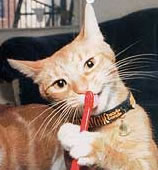 HollisterFreelance.com
HollisterFreelance.com
February 6, 2007 -- By Dr. Quick, Animal Care Center in Morgan Hill
February is National Pet Dental Month
Are you aware that the most common disease of dogs, cats and people is periodontitis - a disease damaging the tissues that support and maintain the teeth? These are also the tissues that separate what is inside the body from what is outside. It is the equivalent of the skin elsewhere on the body and is the first line of defense against infection.
When severe periodontal disease exists, it is comparable to having a gash in your hand that you rub dirt in every day. The mouth is a dirty place and the barrier between inside and outside the body is compromised. What follows is infection, inflammation, pain, swelling and bacterial access to the bloodstream. In people and dogs this can affect the heart valves, leading to heart murmurs and failure. In all animals this bacterial access to the bloodstream can lead to severe and unpredictable health consequences, including organ failure.
In healthy people who take care of their teeth a recent study indicates that almost 37 percent have ongoing damage to the periodontal tissues. For dogs and cats over three years of age the rate of periodontal disease is over 85 percent. These animals usually need care that only a veterinarian can provide, although in the earliest phases home care can be effective. There are generally accepted stages of periodontal disease that determine the level of care required.
Grade 1 periodontitis is simply gingivitis and can often be addressed at home with the help of some instruction from your veterinarian. Cleaning and maintaining the teeth at home at this phase is cheap and can prevent more costly cleanup and repair, so it is worth spending the time and money involved with a veterinary appointment to learn what to do. This will involve brushing the teeth, the use of special diets and special chew toys. There is also a great educational Web site at www.petdental.com which can be very instructive.
With Grade 2 periodontitis, the live tissue at the point of attachment between the tooth and gum is being attacked and infected by bacteria. The barrier between the outside world and the body is being compromised with microscopic pocketing. The gums will tend to look red and inflamed unless they are darkly pigmented. Thickening or swelling of the gums may be subtle, but is obvious to the trained eye. At this point the disease can be completely reversed in many cases, but because we are addressing live tissue, proper cleaning cannot be accomplished without anesthesia to control pain and fear. Those who attempt this without anesthesia are committing both fraud and cruelty to animals.
Grade 3 periodontitis is a more severe manifestation of infection and damage to the gingival and periodontal tissues. At this point there is serious damage to the barrier between inside and outside the body. It is typical for extractions to be part of dental therapy at this point - often leading to the loss of several teeth.
Grade 4 periodontitis is root abcessing. All teeth with grade 4 disease need to be extracted. It is not uncommon to have several different grades of dental disease present in the mouth at the same time. I have seen mouths where there are one or two abcessed teeth and the rest are OK. I have also had mouths in which all the teeth required extraction.
We frequently cannot predict the number of extractions before anesthetizing and examining the mouth. In both dogs and cats a huge build up of calculus can obscure the severity of gum disease. I am often surprised to see relatively healthy and salvageable teeth under calculus deposits that look hopeless and equally surprised to find hopeless damage under only moderate calculus.
In a properly executed dental cleaning and therapy procedure your veterinarian will probe circumferentially around each tooth in the mouth and list the findings on paper - effectively creating a map of your pets' mouth to guide the therapy. Many veterinarians may also use dental x-rays in addition to mapping to make determinations about saving vs. extracting teeth. The use of at least one of these techniques is a basic requirement for proper dental therapy.
The importance of this mapping cannot be overstated. It is said that failure to do proper mapping of the teeth will result in missing half the lesions in the mouth. This in turn will lead to the need for repeated dental care in as little as three to six months. With well executed mapping and treatment, followed by daily home care, you should expect to get one to three years between dental cleanings done under anesthesia.
If you are getting substantially less than this you deserve an explanation as to why that is the case. There are certainly cases where that time frame is unrealistic. Our job is to inform you of that at the time we clean the teeth. It is also our job to describe and show you how to keep the teeth clean at home so that repeated cleanings are minimized.
My next article will discuss anesthetic safety as well as aspects of prevention and home care that can save you money and decrease the need to anesthetize your pet repeatedly.
Dr. Quick has owned and operated the Animal Care Center in Morgan Hill for 25 years. He is a founder of both W.E.R.C. and Furry Friends Foundation and was the Morgan Hill Male Citizen of the Year in 2003.
|